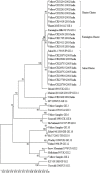Norovirus Gastroenteritis in a Birth Cohort in Southern India
- PMID: 27284939
- PMCID: PMC4902233
- DOI: 10.1371/journal.pone.0157007
Norovirus Gastroenteritis in a Birth Cohort in Southern India
Abstract
Background: Noroviruses are an important cause of gastroenteritis but little is known about disease and re-infection rates in community settings in Asia.
Methods: Disease, re-infection rates, strain prevalence and genetic susceptibility to noroviruses were investigated in a birth cohort of 373 Indian children followed up for three years. Stool samples from 1856 diarrheal episodes and 147 vomiting only episodes were screened for norovirus by RT-PCR. Norovirus positivity was correlated with clinical data, secretor status and ABO blood group.
Results: Of 1856 diarrheal episodes, 207 (11.2%) were associated with norovirus, of which 49(2.6%) were norovirus GI, 150(8.1%) norovirus GII, and 8 (0.4%) were mixed infections with both norovirus GI and GII. Of the 147 vomiting only episodes, 30 (20.4%) were positive for norovirus in stool, of which 7 (4.8%) were norovirus GI and 23 (15.6%) GII. At least a third of the children developed norovirus associated diarrhea, with the first episode at a median age of 5 and 8 months for norovirus GI and GII, respectively. Norovirus GI.3 and GII.4 were the predominant genotypes (40.3% and 53.0%) with strain diversity and change in the predominant sub-cluster over time observed among GII viruses. A second episode of norovirus gastroenteritis was documented in 44/174 (25.3%) ever-infected children. Children with the G428A homozygous mutation for inactivation of the FUT2 enzyme (se428se428) were at a significantly lower risk (48/190) of infection with norovirus (p = 0.01).
Conclusions: This is the first report of norovirus documenting disease, re-infection and genetic susceptibility in an Asian birth cohort. The high incidence and apparent lack of genogroupII specific immunity indicate the need for careful studies on further characterization of strains, asymptomatic infection and shedding and immune response to further our understanding of norovirus infection and disease.
Conflict of interest statement
Figures




Similar articles
-
Norovirus Infection and Disease in an Ecuadorian Birth Cohort: Association of Certain Norovirus Genotypes With Host FUT2 Secretor Status.J Infect Dis. 2015 Jun 1;211(11):1813-21. doi: 10.1093/infdis/jiu672. Epub 2014 Dec 10. J Infect Dis. 2015. PMID: 25505295 Free PMC article.
-
Norovirus infection and HBGA host genetic susceptibility in a birth community-cohort, Rio de Janeiro, Brazil.Infect Genet Evol. 2020 Aug;82:104280. doi: 10.1016/j.meegid.2020.104280. Epub 2020 Mar 9. Infect Genet Evol. 2020. PMID: 32165242
-
Changing pattern of prevalence, genetic diversity, and mixed infections of viruses associated with acute gastroenteritis in pediatric patients in New Delhi, India.J Med Virol. 2018 Mar;90(3):469-476. doi: 10.1002/jmv.24980. Epub 2017 Nov 17. J Med Virol. 2018. PMID: 29064572
-
Norovirus Infections and Disease in Lower-MiddleandLow-Income Countries, 1997⁻2018.Viruses. 2019 Apr 10;11(4):341. doi: 10.3390/v11040341. Viruses. 2019. PMID: 30974898 Free PMC article. Review.
-
Genetic Susceptibility to Human Norovirus Infection: An Update.Viruses. 2019 Mar 6;11(3):226. doi: 10.3390/v11030226. Viruses. 2019. PMID: 30845670 Free PMC article. Review.
Cited by
-
Progress on norovirus vaccine research: public health considerations and future directions.Expert Rev Vaccines. 2018 Sep;17(9):773-784. doi: 10.1080/14760584.2018.1510327. Epub 2018 Aug 27. Expert Rev Vaccines. 2018. PMID: 30092671 Free PMC article. Review.
-
Estimating the incidence of norovirus acute gastroenteritis among US and European international travelers to areas of moderate to high risk of traveler's diarrhea: a prospective cohort study protocol.BMC Infect Dis. 2018 Dec 3;18(1):605. doi: 10.1186/s12879-018-3461-6. BMC Infect Dis. 2018. PMID: 30509202 Free PMC article.
-
Birth Cohort Studies Assessing Norovirus Infection and Immunity in Young Children: A Review.Clin Infect Dis. 2019 Jul 2;69(2):357-365. doi: 10.1093/cid/ciy985. Clin Infect Dis. 2019. PMID: 30753367 Free PMC article.
-
The First Norovirus Longitudinal Seroepidemiological Study From Sub-Saharan Africa Reveals High Seroprevalence of Diverse Genotypes Associated With Host Susceptibility Factors.J Infect Dis. 2018 Jul 24;218(5):716-725. doi: 10.1093/infdis/jiy219. J Infect Dis. 2018. PMID: 29912471 Free PMC article.
-
Norovirus Illnesses in Children and Adolescents.Infect Dis Clin North Am. 2018 Mar;32(1):103-118. doi: 10.1016/j.idc.2017.11.004. Infect Dis Clin North Am. 2018. PMID: 29406972 Free PMC article. Review.
References
MeSH terms
Substances
Grants and funding
LinkOut - more resources
Full Text Sources
Other Literature Sources
Medical

